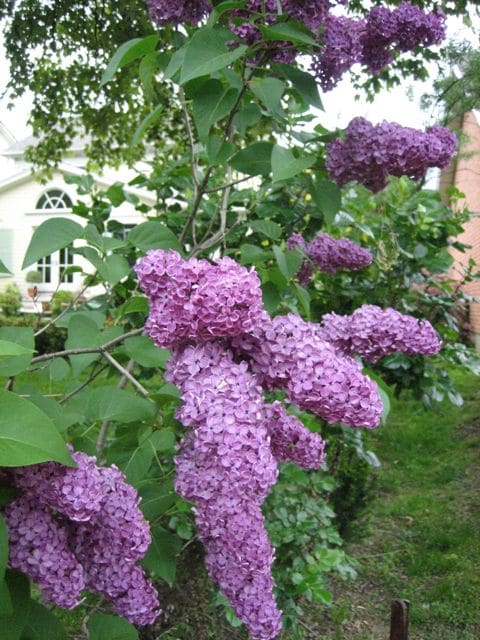
I had a walk around the block this weekend, and it seems like all the spring-flowering shrubs are in bloom at the same time. The alternating weeks of warm and cool temperatures in southern Ontario have confused the orderly progression of bloom, and they’ve expressed their frustration by just getting on with it. I saw Japanese quince, Japanese kerria, magnolia, honeysuckle vines and shrubs, beauty bush, rhododendron, bridalwreath spirea, Korean spice viburnum, the May-blooming ‘Canary Bird’ rose and, of course, lilacs all in flower. Although the plants seem to have taken bloom times into their own hands, there’s far less leeway when it comes to pruning them.
Woody plants that bloom in spring have a resting period of about three to six weeks before they begin preparing flower buds for next year’s bloom. If the plants require hard pruning for size control or just gentle shaping, pruning must be accomplished during the rest phase to avoid cutting off nascent flower buds. It’s easy to forget this as they pass out of bloom and the first wave of early summer perennials begins a distracting display, but if I let the window of opportunity slip by, and start pruning in midsummer, I’ll forfeit next year’s show. However, if I make the necessary cuts and adjustments during the next few weeks, they’ll set their flower buds on the available wood, and I’ll have a better-shaped plant, full of bloom, next spring.
Some shrubs don’t require pruning, while others need a bit of shaping or perhaps removal of dead twigs and branches. The plants that always confound me are lilacs. They want to be 12 to 15 feet (3.5 to 4.5 m) tall, and it’s a mistake to fight the genetic programming that spurs them on to those heights. But a couple of mine are now headed for 20 feet (6 m), and that’s the approximate height of a two-storey house. All the bloom is carried at the top where sunlight is available, above sparse foliage. Attempting to resolve this pruning dilemma is going to require gritting of teeth and patient resolve.
Lilacs respond well to hard pruning, although not in exactly the way we would like. They renew themselves through suckering, sending up a small forest of thin new wood from the roots surrounding central trunks. It’s not unusual for one massive cut to stimulate two or three dozen suckers. It’s all good, viable wood, but perhaps too much. A selection must be made, and most of the suckers will need to be pruned out. The selected new suckers can be allowed to grow on, and eventually will begin blooming in about three years. It might seem a long wait for flowering, but that’s the way lilacs respond and there’s no hurrying them.
There are two scenarios in lilac pruning, and both stimulate new suckers. An old, neglected lilac with multiple trunks and many suckers can be rejuvenated by selectively thinning some wood (both thick central wood and suckers), and cutting them down to the ground. As new suckers rise in response to the pruning, determine which will remain and eliminate the others. The second method is best for tall, gangly lilac trunks with no suckers present. This is a gradual pruning, cutting one large trunk to the ground each year until the plant is entirely replaced by sucker growth. Once the large trunks are removed, the renovated lilac will be entirely replaced by suckers and a few of these must be removed each year.
Although I’ll miss a few years of flowering from these two lilacs, I enjoy pruning. It’s a quiet pleasure, and will eventually result in lilac flowers at nose level.

i had a lovely show of blooms on my dwarf Korean lilac this year and i recall pruning it last year after blooming for the first time, and it obviously really helped.. but i can’t remember exactly what i did.. do i cut off all the flowers down to the wood… help please Judith!
Just yesterday I stared up at the blooms on the end of a tall, gangly trunk of our Beauty of Moscow lilac and wondered: to prune or not to prune? And now I know. “….gritting of teeth and patient resolve” will definitely be required, but having lilacs at nose level will be worth the wait! Thanks Judith.
Pruning deciduous shrubs can be divided into 4 groups: Those that require minimal pruning (take out only dead, diseased, damaged, or crossed branches, can be done in early spring.); spring pruning (encourages vigorous, new growth which produces summer flowers – in other words, flowers appear on new wood); summer pruning after flower (after flowering, cut back shoots, and take out some of the old growth, down to the ground); suckering habit pruning (flowers appear on wood from previous year. Cut back flowered stems by 1/2, to strong growing new shoots and remove 1/2 of the flowered stems a couple of inches from the ground) Always remove dead, damaged or diseased wood first, no matter what type of pruning you are doing.